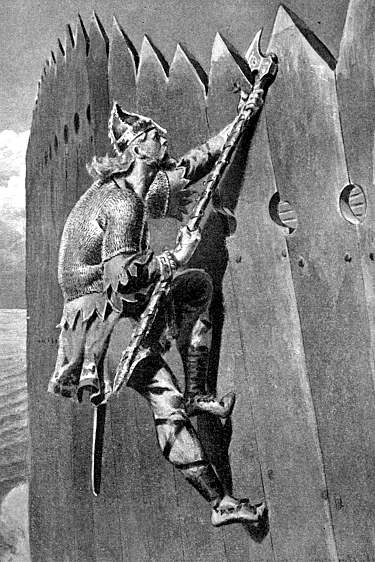
|

|
Ţrándur Ingjaldsson
born: in Iceland
died: in Iceland
The sagas tell stories not just of heroes, but also of ordinary men and women in the Viking age. Ţrándur was one of those ordinary people who, when circumstances required, showed himself capable of some extraordinary moves with weapons.
Ţrándur was a farmer who once had been a part of Snorri gođi's household. He was big, strong, and a fast runner. Snorri sent a messenger to Ţrándur asking him to come to take part in a dangerous enterprise. A group of brigands and thieves, led by Óspakur and Hrafn the Viking, had taken over the farm at Eyr and had fortified it.
The nature of Viking-age fortifications is not fully understood, but perhaps it was in the form of some kind of palisade wall or fence. Using the stronghold as their base, the bandits created trouble throughout the district. Snorri gođi meant to get rid of the problem. He asked a number of his supporters and neighbors to help him attack the fortification.
Snorri and his men traveled to Eyr and the battle began.
 |
Snorri and his supporters kept up such a barrage of missiles that Hrafn and his men retreated behind the wall of the fortification. Then Thrand made a running leap at the wall, jumping high enough to be able to hook his axe over the top of the wall and then to pull himself up by the axe-handle until he got onto the fortification. When Hrafn saw that a man had got into the fortification, he rushed at Thrand with his spear, but Thrand warded off the lunge and swung at Hrafn's shoulder, cutting off his arm. Many men then rushed him, but he jumped off the wall of the fortification and got back to his men. Eyrbyggja saga, ch. 62 |
Ţrándur's move was a clever use of the tool he had available: his axe. His move seems typical of fighters in the Viking age: he used the tools he had available to make the move required by circumstances to succeed in his struggle to clear the stronghold. Yet, it wasn't an elite fighter, but rather, an ordinary farmer who used the clever move. This episode (and others like it) suggests that many Viking-age fighting men, at all levels of society, were skilled and clever in the use of weapons.
The episode also shows the nature of government in Viking-age Iceland. The Icelanders created an advanced form of government, based on Norwegian law, but intentionally avoided any kind of central authority such as a king or earl. Their government had a legislative branch (to make laws) and a judicial branch (to judge laws) but no executive. There was no police or army or sheriff. If there was a disturbance, prominent men, such as Snorri gođi, called fighters together to resolve the situation.
Once Ţrándur wounded the leader to the brigands, their will was broken, and they offered to surrender on the condition that none of them would be further maimed or killed. Snorri gođi accepted the surrender. A few were allowed to stay, but most were driven away.
|
|
©2013-2025 William R. Short |